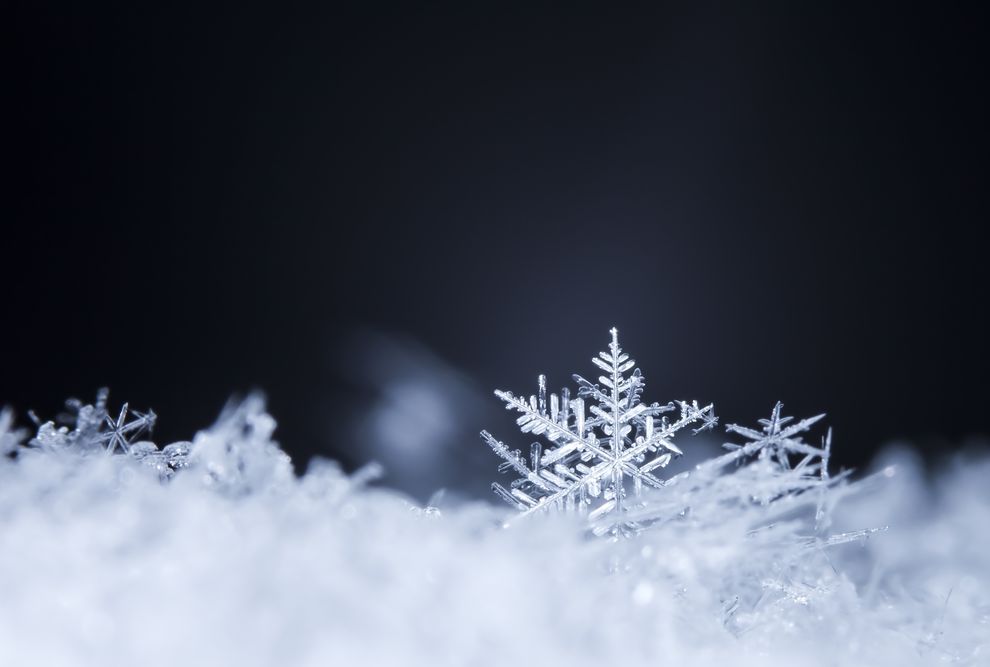雪中充满了微小的生命
雪中充满了微小的生命
Frosty the Snowman famously came to life one day with the help of a magical silk hat. As recent research suggests, however, he and other snowmen might already be more "alive" than most people realize — even if they aren't dancing around with broomstick canes. That's because, regardless of how it's sculpted or adorned, snow itself is often surprisingly full of microbial life.
有一天,雪人Frosty在一顶神奇的丝绸帽子的帮助下苏醒了过来。然而,最近的研究表明,他和其他雪人可能已经比大多数人意识到的更“活跃”了——即使他们没有拿着扫帚和拐杖跳舞。这是因为,无论如何雕刻或装饰,雪本身往往充满了令人惊讶的微生物生命。

Photo: ch123/Shutterstock
That includes snow that's been lying on the ground for weeks or months, but freshly fallen snow can teem with tiny creatures, too. Some microbes even play key roles in the formation of snowflakes long before they fall.
这包括已经在地上躺了几周或几个月的雪,但是新落下的雪也会有很多小生物。有些微生物甚至在雪花形成过程中起着关键作用。
Although life generally depends on liquid water, a variety of organisms have evolved impressive techniques for surviving in snow and ice. They may wait for seasonal thaws, slow their metabolisms, produce antifreeze proteins or encourage the snow around them to melt. A few have been known to science for a long time, but many have only been discovered in recent years.
虽然生命通常依赖液态水,但各种各样的生物体已经进化出了在冰雪中生存的令人印象深刻的技术。它们可能会等待季节性的解冻,减缓新陈代谢,产生防冻蛋白,或者促使周围的雪融化。一些已经为科学界所知很长一段时间了,但是许多是最近几年才被发现的。
There is "watermelon snow," for example, whose pink or red color was documented centuries ago by Aristotle. It wasn't until the 19th century, though, that scientists realized it was caused by something alive in the snow. We now know it can be caused by a few kinds of algae, including Chlamydomonas nivalis, which is often found in mountains, polar regions and other places where snow lasts all year. The algae themselves are green, but they produce a red pigment as a defense against UV radiation. The pigment also reduces the albedo of snow, helping it melt and support more algae. The algae help other life inhabit snow, too, by serving as prey for creatures like ice worms, nematodes, rotifers and tardigrades.
比如“西瓜雪”,它的粉色或红色早在几个世纪前就被亚里士多德记录下来了。然而,直到19世纪,科学家们才意识到它是由雪中的某种生物引起的。我们现在知道它可能是由几种藻类引起的,包括经常在山区、极地和其他终年下雪的地方发现的nivalis衣藻。藻类本身是绿色的,但它们会产生一种红色色素来抵御紫外线辐射。这种色素还能降低雪的反照率,帮助雪融化并支持更多的藻类。这些藻类也帮助其他生物栖息在雪中,它们是冰虫、线虫、轮虫和缓步动物的猎物。
Even if snow is pristinely white, it may still host a wealth of microbial life. That's what researchers recently found after looking for microbial DNA in snow samples from Northern Europe and North America. Published earlier this year in the journal Microbial Ecology, their findings reveal a hidden empire of bacteria, fungi and algae in seemingly lifeless snow. "I was just blown away by the biodiversity," co-author Shawn Brown, a professor of biology at the University of Memphis, told New Scientist.
即使雪是原始的白色,它仍然可能有丰富的微生物生命。这是研究人员最近在北欧和北美的雪样本中寻找微生物DNA后发现的。今年早些时候发表在《微生物生态学》杂志上的发现揭示了一个隐藏在看似没有生命的雪地里的细菌、真菌和藻类帝国。“我被生物多样性震惊了,”论文的合著者、孟菲斯大学的生物学教授肖恩·布朗告诉《新科学家》杂志。
Snow often carries microbes before it even reaches the ground, and in some cases it may not have formed without them. Like raindrops, snowflakes develop in the sky when water molecules cluster around some kind of nucleus. That could be a particle of dust or soot, but research suggests many snowflakes form around a bacterium of the species Pseudomonas syringae.
雪通常在到达地面之前就携带了微生物,在某些情况下,如果没有它们,雪可能就不会形成。就像雨滴一样,当水分子聚集在原子核周围时,雪花就会在天空中形成。那可能是一粒灰尘或煤烟,但研究表明,许多雪花是在一种名为“丁香假单胞菌”的细菌周围形成的。
These bacteria float into the sky as moisture evaporates from foliage and soil, or they can just be whisked into the atmosphere by wind. Their surfaces have proteins that are highly effective at prompting water to freeze, so once they're up in a cloud, water molecules cluster around them, freeze and fall as precipitation. P. syringae is so helpful for snow formation that it's often used to create artificial snow for ski slopes, according to Micropia, a museum in Amsterdam dedicated to microbes.
当水分从树叶和土壤中蒸发时,这些细菌会飘浮到空中,或者它们会被风吹到大气中。它们的表面有一种蛋白质,能有效地促使水结冰,所以一旦它们在云层里,水分子就会聚集在它们周围,冻结并沉淀下来。阿姆斯特丹一家专门研究微生物的博物馆Micropia称,紫丁香对雪的形成非常有帮助,经常被用来为滑雪场制造人工雪。
There are also algae that live in glaciers and sea ice, as well as other ice-adapted microbes that remain shrouded in mystery or have yet to be discovered. Scientists have found intriguing hints of bacterial life in Antarctica, for example, in surface snow as well as in dark lakes sealed deep below an enormous ice sheet.
也有藻类生活在冰川和海冰中,还有其他适应冰的微生物仍然笼罩在神秘之中或尚未被发现。科学家们在南极洲发现了有趣的细菌生命迹象,例如,在表面的雪中,以及深埋在巨大冰原下的黑暗湖泊中。
Many snow and ice microbes may play important ecological roles, but we still have a lot to learn about where they live, what they do and how they work. Unfortunately, some of these cold-adapted microbes may soon see their habitats transformed by human-induced climate change, which is widely melting ice and scrambling snowfall patterns.
许多冰雪微生物可能扮演着重要的生态角色,但关于它们生活在哪里、它们做什么以及它们是如何工作的,我们还有很多要了解。不幸的是,一些适应寒冷的微生物可能很快就会看到它们的栖息地被人类引起的气候变化所改变,这是广泛融化的冰和混乱的降雪模式。
Snow and ice would be beautiful even if they were lifeless, so their support of mysterious microbial communities is yet another reason not only to appreciate the world we've inherited, but also to do what we can to protect it. An extinction crisis increasingly threatens species around the planet, and unlike Frosty, vanishing wildlife can rarely promise to "be back again someday."
即使没有生命,冰雪也会是美丽的,因此,它们对神秘微生物群落的支持,不仅是我们欣赏这个世界的另一个理由,也是我们尽力保护它的另一个理由。一场灭绝危机正日益威胁着地球上的物种,而与霜冻不同的是,正在消失的野生动物很少能保证“有一天会再回来”。


















